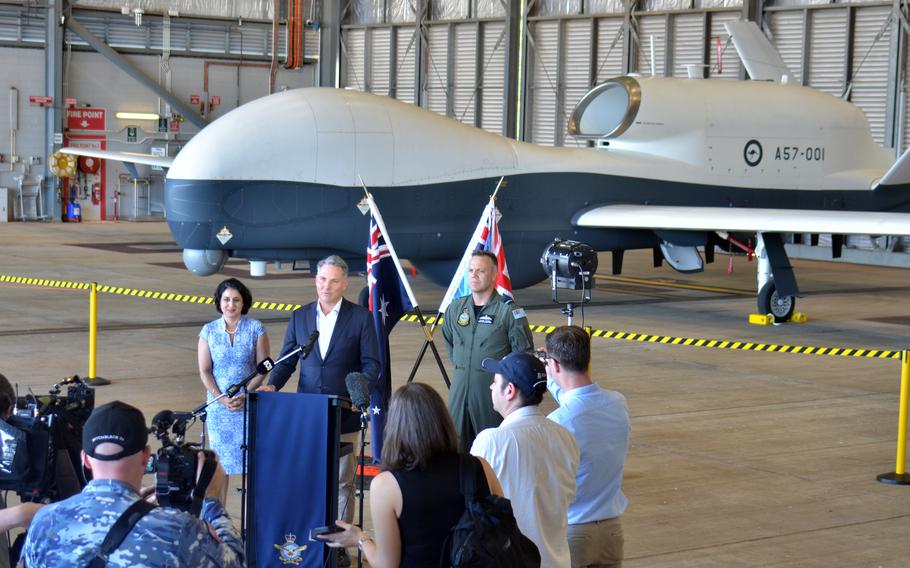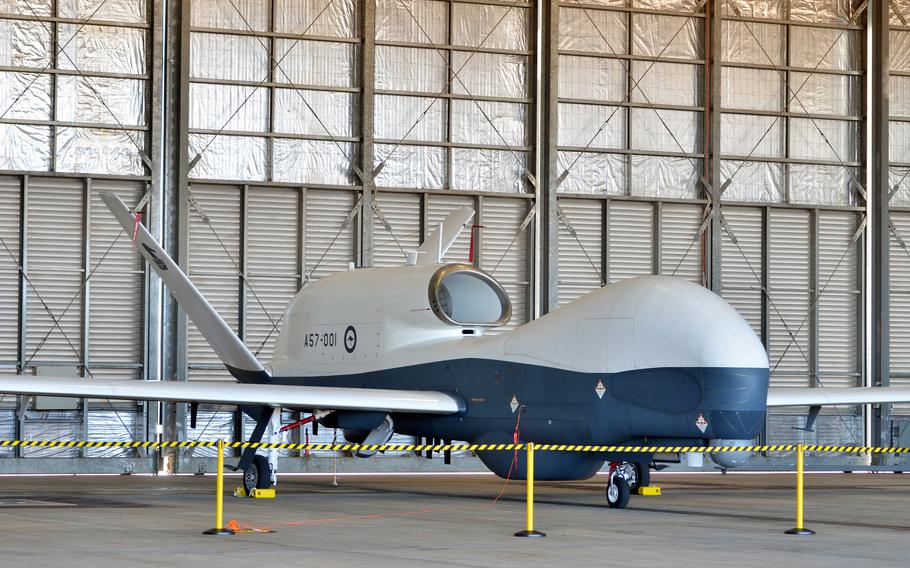
Australian Deputy Prime Minister Richard Marles, flanked by Northrop Grumman Australia chief executive Christine Zeitz and the head of nation's air force, Air Marshal Stephen Chappell, speaks about new MQ-4C Tritons at Royal Australian Air Force Base Tindal, Wednesday, July 31, 2024. (Seth Robson/Stars and Stripes)
ROYAL AUSTRALIAN AIR FORCE BASE TINDAL, Australia — The first of four MQ-4C Triton drones being added to Australia’s arsenal debuted at this northern air base Wednesday.
Australia is spending $1.6 billion on its Triton fleet, Deputy Prime Minister Richard Marles told reporters in front of the new aircraft alongside Australian air force chief Air Marshal Stephen Chappell.
“This platform is designed to fly missions of 24 hours, and in that you would see a journey which is equivalent to a trans-Pacific flight,” Marles said.
The drone could surveil an area as large as the sprawling state of Western Australia, he said.
“We are a country surrounded by oceans with vast approaches to our nation, and so the areas that we need to surveil in order to keep our nation safe are massive,” he said.
The Triton is capable of civil missions, but its primary role will be military — keeping tabs on potential adversaries’ warships and submarines, Marles said.
U.S. Navy Tritons have flown from Guam since January 2020 and have since deployed to bases in Japan and Okinawa.

The first of four MQ-4C Tritons being added to Australia’s arsenal debuts at Royal Australian Air Force Base Tindal, Wednesday, July 31, 2024. (Seth Robson/Stars and Stripes)
The drones, made by U.S. aerospace company Northrop Grumman, look like RQ-4 Global Hawks, which have seen extensive service in Iraq and Afghanistan, but the resemblance is skin deep.
The front edges of the Tritons’ wings have been toughened to withstand bird strikes, while their electronics are designed to withstand lightning strikes. The maritime drones’ stiff wings allow them to dive below 10,000 feet to get a closer look at floating targets.
The U.S. government is spending nearly $450 million on improvements to military bases in Australia’s Northern Territory, including RAAF Tindal.
Estimates of U.S. spending at the base, tagged as a location for future B-52 Stratofortress bomber rotations, include $90 million for a fuel farm, $35 million for office and maintenance facilities, $100-$140 million for a bomber ramp and $80-$100 million for a hangar.
A group of Northrop technicians at the Triton unveiling included Rodney Thompson, who usually works with Unmanned Patrol Squadron 19 at Naval Air Station Jacksonville, Fla.
The Americans are at Tindal to help their Australian counterparts set up a forward operating base, he said. The aircraft will take off and land there but be piloted from RAAF Edinburgh in South Australia.
The Tritons will be operated by Australia’s No. 9 Squadron, Chappell said, a unit that operated flying boats in World War II and helicopters in the Vietnam War.